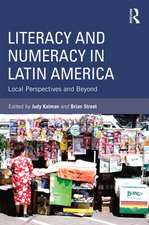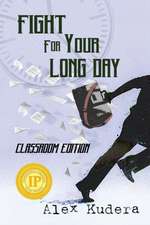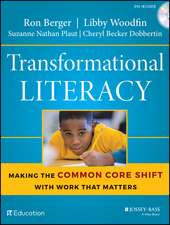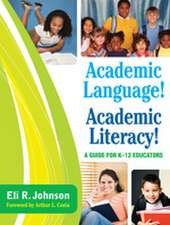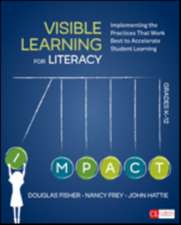Developing Content Area Literacy: 40 Strategies for Middle and Secondary Classrooms
Autor Patricia A. Antonacci, Catherine M. O'Callaghan, Esther Berkowitzen Limba Engleză Paperback – 16 dec 2014
Key Features
- Specific approaches to differentiating instruction for striving or struggling readers and writers as well as English language learners are included.
- Easy-to-follow, step-by-step procedures for each strategy are organized around “before,” “during,” and “after” reading and writing instruction.
- New and innovative ways to implement technology in the classroom are included along with coverage of media and digital literacies.
Preț: 520.80 lei
Preț vechi: 703.78 lei
-26% Nou
Puncte Express: 781
Preț estimativ în valută:
99.66€ • 103.46$ • 83.11£
99.66€ • 103.46$ • 83.11£
Carte disponibilă
Livrare economică 01-15 martie
Livrare express 18-22 februarie pentru 39.81 lei
Preluare comenzi: 021 569.72.76
Specificații
ISBN-13: 9781483347646
ISBN-10: 1483347648
Pagini: 352
Ilustrații: illustrations
Dimensiuni: 216 x 279 x 18 mm
Greutate: 0.8 kg
Ediția:Second Edition
Editura: SAGE Publications
Colecția Sage Publications, Inc
Locul publicării:Thousand Oaks, United States
ISBN-10: 1483347648
Pagini: 352
Ilustrații: illustrations
Dimensiuni: 216 x 279 x 18 mm
Greutate: 0.8 kg
Ediția:Second Edition
Editura: SAGE Publications
Colecția Sage Publications, Inc
Locul publicării:Thousand Oaks, United States
Recenzii
"Antonacci and O'Callaghan have truly brought content literacy into the technology age with this book, a must-have text that combines classic strategies with digital and other new literacies to prepare teachers for the 21st century classroom!"
“Developing Content Area Literacy provides 40 strategies for middle and secondary classrooms in a format that not only makes the strategies easy to use in the classrooms, but also provides the research behind each one.”
“I like the way each strategy is in its own comprehensive chapter with overviews, step-by-step procedures, differentiation, focus on ELLs, and application of the strategy. Because each has its own chapter, it makes it easy to find/reference each one.”
“Developing Content Area Literacy provides 40 strategies for middle and secondary classrooms in a format that not only makes the strategies easy to use in the classrooms, but also provides the research behind each one.”
“I like the way each strategy is in its own comprehensive chapter with overviews, step-by-step procedures, differentiation, focus on ELLs, and application of the strategy. Because each has its own chapter, it makes it easy to find/reference each one.”
Cuprins
Section I. Academic Vocabulary: Developing Vocabulary for Learning in Content Areas
What Research Has to Say on the Development of Academic Vocabulary
A Framework for Teaching Academic Vocabulary to Adolescent Learners
A Strategy for Assessing the Development of Academic Vocabulary
Reflective Practice on Teaching Academic Vocabulary
Chapter 1: Semantic Mapping: Developing Robust Academic Vocabularies
Strategy Overview
Step-by-Step Procedure
Differentiating Instruction for Striving Readers
Considering the Language Needs of English Language Learners (Academic Discourse)
Integrating the New Literacies
An Application for a Mathematics Learning Community
Chapter 2: Vocabulary Self-Collection Strategy: Promoting Word Consciousness
Strategy Overview
Step-by-Step Procedure
Differentiating Instruction for Striving Readers
Considering the Language Needs of English Language Learners (Academic Discourse)
Integrating the New Literacies
An Application for a Business Learning Community
Chapter 3: Contextual Redefinition: Using Clues as a Word-Learning Strategy
Strategy Overview
Step-by-Step Procedure
Differentiating Instruction for Striving Readers
Considering the Language Needs of English Language Learners (Academic Discourse)
Integrating the New Literacies
An Application for a Biology Learning Community
Chapter 4: Semantic Feature Analysis: Comparing and Contrasting Features of Words
Strategy Overview
Step-by-Step Procedure
Differentiating Instruction for Striving Readers
Considering the Language Needs of English Language Learners (Academic Discourse)
Integrating the New Literacies
An Application for a Health Learning Community
Chapter 5: Blogging Academic Vocabulary: Integrating Subject-Matter Discourse Into Media
Strategy Overview
Step-by-Step Procedure
Differentiating Instruction for Striving Readers
Considering the Language Needs of English Language Learners (Academic Discourse)
Integrating the New Literacies
An Application for a Political Science Learning Community
Section II. Reading Fluency: Developing Deep-Reading Fluency
What Research Has to Say About the Development of Reading Fluency
A Framework for Teaching Reading Fluency to Adolescent Students
A Strategy for Assessing Reading Fluency Development
Reflective Practice on Teaching Reading Fluency
Chapter 6: Readers Theatre: Increasing Fluency Through Student Engagement With Text
Strategy Overview
Step-by-Step Procedure
Differentiating Instruction for Striving Readers
Considering the Language Needs of English Language Learners (Academic Discourse)
Integrating the New Literacies
An Application for a Social Studies Learning Community
Chapter 7: Paired Reading: A Collaborative Approach for Developing Deep-Reading Fluency
Strategy Overview
Step-by-Step Procedure
Differentiating Instruction for Striving Readers
Considering the Language Needs of English Language Learners (Academic Discourse)
Integrating the New Literacies
An Application for a Visual Arts Learning Community
Chapter 8: Audiobooks: Modeling and Scaffolding Reading Fluency
Strategy Overview
Step-by-Step Procedure
Differentiating Instruction for Striving Readers
Considering the Language Needs of English Language Learners (Academic Discourse)
Integrating the New Literacies
An Application for an Integrated English Language Arts and Social Studies Learning Community
Chapter 9: Radio Reading: An Authentic Approach for Developing Reading Fluency
Strategy Overview
Step-by-Step Procedure
Differentiating Instruction for Striving Readers
Considering the Language Needs of English Language Learners (Academic Discourse)
Integrating the New Literacies
An Application for an Economics Learning Community
Chapter 10: Morphemic Analysis: A Useful Resource for Becoming a Fluent Reader
Strategy Overview
Step-by-Step Procedure
Differentiating Instruction for Striving Readers
Considering the Language Needs of English Language Learners (Academic Discourse)
Integrating the New Literacies
An Application for a Physics Learning Community
Section III. Developing Close Reading of Text: Essential Strategies for Teaching Close Reading
What Research Has to Say About the Development of Close Reading of Text
A Framework for Teaching Close Reading to Adolescent Learners
A Strategy for Assessing Close Reading of Text
Reflective Practice on Teaching Close Reading of Text
Chapter 11: Annotation: Strategic Analysis of Text
Strategy Overview
Step-by-Step Procedure
Differentiating Instruction for Striving Readers
Considering the Language Needs of English Language Learners (Academic Discourse)
Integrating the New Literacies
An Application for a Science Learning Community
Chapter 12: Interactive Think-Alouds: Collaborative Interpretation of Text
Strategy Overview
Step-by-Step Procedure
Differentiating Instruction for Striving Readers
Considering the Language Needs of English Language Learners (Academic Discourse)
Integrating the New Literacies
An Application for an English Literature Learning Community
Chapter 13: Inference Strategy Guide: Facilitating Reading Between the Lines
Strategy Overview
Step-by-Step Procedure
Differentiating Instruction for Striving Readers
Considering the Language Needs of English Language Learners (Academic Discourse)
Integrating the New Literacies
An Application for a Social Studies Learning Community
Chapter 14: The Inquirer Strategy: Learning to Ask Questions
Strategy Overview
Step-by-Step Procedure
Differentiating Instruction for Striving Readers
Considering the Language Needs of English Language Learners (Academic Discourse)
Integrating the New Literacies
An Application for a Social Studies Learning Community
Chapter 15: Active Interpretation of Film: Making Inferences Through Visual Media
Strategy Overview
Step-by-Step Procedure
Differentiating Instruction for Striving Readers
Considering the Language Needs of English Language Learners (Academic Discourse)
Integrating the New Literacies
An Application for an English Literature Learning Community
Section IV. Reading Informational Text: Developing Comprehension for Informational Text
What Research Has to Say About the Comprehension of Informational Text
A Framework for Teaching Comprehension of Informational Text to Adolescent Students
A Strategy for Assessing the Development of Comprehending Informational Text
Reflective Practice on Teaching Comprehension of Informational Text
Chapter 16: Questioning the Author: Constructing Meaning From the Text
Strategy Overview
Step-by-Step Procedure
Differentiating Instruction for Striving Readers
Considering the Language Needs of English Language Learners (Academic Discourse)
Integrating the New Literacies
An Application for a Social Studies Learning Community
Chapter 17: Text Structure Strategy: Using Graphic Organizers to Learn From Informational Text
Strategy Overview
Step-by-Step Procedure
Differentiating Instruction for Striving Readers
Considering the Language Needs of English Language Learners (Academic Discourse)
Integrating the New Literacies
An Application for a Music Learning Community
Chapter 18: Connect to It: Making Personal, Text, and World Connections to Text
Strategy Overview
Step-by-Step Procedure
Differentiating Instruction for Striving Readers
Considering the Language Needs of English Language Learners (Academic Discourse)
Integrating the New Literacies
An Application for a Mathematics, Science, and Technology Learning Community
Chapter 19: Inquiry Charts: Organizing Information for Learning From Texts
Strategy Overview
Step-by-Step Procedure
Differentiating Instruction for Striving Readers
Considering the Language Needs of English Language Learners (Academic Discourse)
Integrating the New Literacies
An Application for an Environmental Science Learning Community
Chapter 20: Digital Pattern Folders: Comprehending Multimodal Texts
Strategy Overview
Step-by-Step Procedure
Differentiating Instruction for Striving Readers
Considering the Language Needs of English Language Learners (Academic Discourse)
Integrating the New Literacies
An Application for a Health and Wellness Learning Community
Section V. Media and Digital Literacies: Developing Comprehension for Media and Digital Literacies
What Research Has to Say About the Comprehension of Media and Digital Literacies
A Framework for Teaching Comprehension of Media and Digital Literacies to Adolescent Learners
A Strategy for Assessing Comprehension of Digital Text
Reflective Practice on Teaching Digital and Media Literacies
Chapter 21: Think and Check: Contextualizing and Corroborating Online Information
Strategy Overview
Step-by-Step Procedure
Differentiating Instruction for Striving Readers
Considering the Language Needs of English Language Learners (Academic Discourse)
Integrating the New Literacies
An Application for a Social Studies Learning Community
Chapter 22: Digital Storytelling: Creating Digital Text
Strategy Overview
Step-by-Step Procedure
Differentiating Instruction for Striving Readers
Considering the Language Needs of English Language Learners (Academic Discourse)
Integrating the New Literacies
An Application for a Biology Learning Community
Chapter 23: Wikibooks: Collaborative Research Projects
Strategy Overview
Step-by-Step Procedure
Differentiating Instruction for Striving Readers
Considering the Language Needs of English Language Learners (Academic Discourse)
Integrating the New Literacies
An Application for a Geometry Learning Community
Chapter 24: Podcasting: Merging Media for Understanding
Strategy Overview
Step-by-Step Procedure
Differentiating Instruction for Striving Readers
Considering the Language Needs of English Language Learners (Academic Discourse)
Integrating the New Literacies
An Application for a Music Learning Community
Chapter 25: Book Trailers: Insights and Discoveries About Texts
Strategy Overview
Step-by-Step Procedure
Differentiating Instruction for Striving Readers
Considering the Language Needs of English Language Learners (Academic Discourse)
Integrating the New Literacies
An Application for an Art Learning Community
Section VI. Critical Thinking: Developing Students’ Critical Thinking Skills
What Research Has to Say About the Development of Critical Thinking
A Framework for Teaching Critical Thinking Skills to Adolescent Students
A Strategy for Assessing the Development of Critical Thinking Skills
Reflective Practice on Teaching Critical Thinking Skills
Chapter 26: SCAMPER: Collaborative Analysis of Text
Strategy Overview
Step-by-Step Procedure
Differentiating Instruction for Striving Readers
Considering the Language Needs of English Language Learners (Academic Discourse)
Integrating the New Literacies
An Application for a Psychology Learning Community
Chapter 27: Six Thinking Hats: Facilitating Different Modes of Thinking
Strategy Overview
Step-by-Step Procedure
Differentiating Instruction for Striving Readers
Considering the Language Needs of English Language Learners (Academic Discourse)
Integrating the New Literacies
An Application for a Science Learning Community
Chapter 28: Academic Controversy: Taking Sides on the Issue
Strategy Overview
Step-by-Step Procedure
Differentiating Instruction for Striving Readers
Considering the Language Needs of English Language Learners (Academic Discourse)
Integrating the New Literacies
An Application for a Health Learning Community
Chapter 29: Three-Level Reading Guide: Developing Literal, Interpretive, and Applied Reading of Text
Strategy Overview
Step-by-Step Procedure
Differentiating Instruction for Striving Readers
Considering the Language Needs of English Language Learners (Academic Discourse)
Integrating the New Literacies
An Application for a Career Development Learning Community
Chapter 30: Request Reciprocal Teaching: Collaborative Critical Thinking
Strategy Overview
Step-by-Step Procedure
Differentiating Instruction for Striving Readers
Considering the Language Needs of English Language Learners (Academic Discourse)
Integrating the New Literacies
An Application for a Physics Learning Community
Section VII. Writing Informational Text: Developing Writing in the Content Areas
What Research Has to Say About the Development of Students’ Writing
Best Practices in Academic Writing Instruction
A Framework for Teaching Informational Writing Skills to Adolescent Students
A Strategy for Assessing the Development of Students’ Writing of Informational Text
Reflective Practice on the Teaching of Writing of Informational Text
Chapter 31: Concept Star: Visualization for a Prewriting Strategy
Strategy Overview
Step-by-Step Procedure
Differentiating Instruction for Striving Readers
Considering the Language Needs of English Language Learners (Academic Discourse)
Integrating the New Literacies
An Application for a History Learning Community
Chapter 32: Concept Mind Map: Facilitating Collaborative Writing
Strategy Overview
Step-by-Step Procedure
Differentiating Instruction for Striving Readers
Considering the Language Needs of English Language Learners (Academic Discourse)
Integrating the New Literacies
An Application for a Chemistry Learning Community
Chapter 33: Research for Choice: Facilitating Student Voice in Academic Writing
Strategy Overview
Step-by-Step Procedure
Differentiating Instruction for Striving Readers
Considering the Language Needs of English Language Learners (Academic Discourse)
Integrating the New Literacies
An Application for a Mathematics Learning Community
Chapter 34: Shared Pen: Interactive and Collaborative Writing
Strategy Overview
Step-by-Step Procedure
Differentiating Instruction for Striving Readers
Considering the Language Needs of English Language Learners (Academic Discourse)
Integrating the New Literacies
An Application for a Business Education Learning Community
Chapter 35: Targeted Text: Guided Writing of Informational Text
Strategy Overview
Step-by-Step Procedure
Differentiating Instruction for Striving Readers
Considering the Language Needs of English Language Learners (Academic Discourse)
Integrating the New Literacies
An Application for a Health Learning Community
Section VIII. Independent Learning Strategies: Promoting Strategies for Independence in Learning
What Research Has to Say About Developing Independence in Learning
A Framework for Teaching Independent Learning to Adolescent Students
Assessment of Students’ Independence in Learning
Reflective Practice on Teaching Independent Learning
Chapter 36: Talking Around the Text: Using Dialogic Reading and Writing to Promote Independent Learners
Strategy Overview
Step-by-Step Procedure
Differentiating Instruction for Striving Readers
Considering the Language Needs of English Language Learners (Academic Discourse)
Integrating the New Literacies
An Application for a Social Studies Learning Community
Chapter 37: Textbook Activity Guide: Developing Independence in Learning From the Textbook
Strategy Overview
Step-by-Step Procedure
Differentiating Instruction for Striving Readers
Considering the Language Needs of English Language Learners (Academic Discourse)
Integrating the New Literacies
An Application for a General Science Learning Community
Chapter 38: Academic Note Taking: Supporting Students’ Independence in Learning
Strategy Overview
Step-by-Step Procedure
Differentiating Instruction for Striving Readers
Considering the Language Needs of English Language Learners (Academic Discourse)
Integrating the New Literacies
An Application for a Studio Arts Learning Community
Chapter 39: Entrance and Exit Slips: Helping Students to Reflect on Their Learning
Strategy Overview
Step-by-Step Procedure
Differentiating Instruction for Striving Readers
Considering the Language Needs of English Language Learners (Academic Discourse)
Integrating the New Literacies
An Application for an Agriculture Science Learning Community
Chapter 40: Journaling: Helping Students to Respond, Reflect, and Learn Through Informal Writing
Strategy Overview
Step-by-Step Procedure
Differentiating Instruction for Striving Readers
Considering the Language Needs of English Language Learners (Academic Discourse)
Integrating the New Literacies
Applications of Journal Writing
What Research Has to Say on the Development of Academic Vocabulary
A Framework for Teaching Academic Vocabulary to Adolescent Learners
A Strategy for Assessing the Development of Academic Vocabulary
Reflective Practice on Teaching Academic Vocabulary
Chapter 1: Semantic Mapping: Developing Robust Academic Vocabularies
Strategy Overview
Step-by-Step Procedure
Differentiating Instruction for Striving Readers
Considering the Language Needs of English Language Learners (Academic Discourse)
Integrating the New Literacies
An Application for a Mathematics Learning Community
Chapter 2: Vocabulary Self-Collection Strategy: Promoting Word Consciousness
Strategy Overview
Step-by-Step Procedure
Differentiating Instruction for Striving Readers
Considering the Language Needs of English Language Learners (Academic Discourse)
Integrating the New Literacies
An Application for a Business Learning Community
Chapter 3: Contextual Redefinition: Using Clues as a Word-Learning Strategy
Strategy Overview
Step-by-Step Procedure
Differentiating Instruction for Striving Readers
Considering the Language Needs of English Language Learners (Academic Discourse)
Integrating the New Literacies
An Application for a Biology Learning Community
Chapter 4: Semantic Feature Analysis: Comparing and Contrasting Features of Words
Strategy Overview
Step-by-Step Procedure
Differentiating Instruction for Striving Readers
Considering the Language Needs of English Language Learners (Academic Discourse)
Integrating the New Literacies
An Application for a Health Learning Community
Chapter 5: Blogging Academic Vocabulary: Integrating Subject-Matter Discourse Into Media
Strategy Overview
Step-by-Step Procedure
Differentiating Instruction for Striving Readers
Considering the Language Needs of English Language Learners (Academic Discourse)
Integrating the New Literacies
An Application for a Political Science Learning Community
Section II. Reading Fluency: Developing Deep-Reading Fluency
What Research Has to Say About the Development of Reading Fluency
A Framework for Teaching Reading Fluency to Adolescent Students
A Strategy for Assessing Reading Fluency Development
Reflective Practice on Teaching Reading Fluency
Chapter 6: Readers Theatre: Increasing Fluency Through Student Engagement With Text
Strategy Overview
Step-by-Step Procedure
Differentiating Instruction for Striving Readers
Considering the Language Needs of English Language Learners (Academic Discourse)
Integrating the New Literacies
An Application for a Social Studies Learning Community
Chapter 7: Paired Reading: A Collaborative Approach for Developing Deep-Reading Fluency
Strategy Overview
Step-by-Step Procedure
Differentiating Instruction for Striving Readers
Considering the Language Needs of English Language Learners (Academic Discourse)
Integrating the New Literacies
An Application for a Visual Arts Learning Community
Chapter 8: Audiobooks: Modeling and Scaffolding Reading Fluency
Strategy Overview
Step-by-Step Procedure
Differentiating Instruction for Striving Readers
Considering the Language Needs of English Language Learners (Academic Discourse)
Integrating the New Literacies
An Application for an Integrated English Language Arts and Social Studies Learning Community
Chapter 9: Radio Reading: An Authentic Approach for Developing Reading Fluency
Strategy Overview
Step-by-Step Procedure
Differentiating Instruction for Striving Readers
Considering the Language Needs of English Language Learners (Academic Discourse)
Integrating the New Literacies
An Application for an Economics Learning Community
Chapter 10: Morphemic Analysis: A Useful Resource for Becoming a Fluent Reader
Strategy Overview
Step-by-Step Procedure
Differentiating Instruction for Striving Readers
Considering the Language Needs of English Language Learners (Academic Discourse)
Integrating the New Literacies
An Application for a Physics Learning Community
Section III. Developing Close Reading of Text: Essential Strategies for Teaching Close Reading
What Research Has to Say About the Development of Close Reading of Text
A Framework for Teaching Close Reading to Adolescent Learners
A Strategy for Assessing Close Reading of Text
Reflective Practice on Teaching Close Reading of Text
Chapter 11: Annotation: Strategic Analysis of Text
Strategy Overview
Step-by-Step Procedure
Differentiating Instruction for Striving Readers
Considering the Language Needs of English Language Learners (Academic Discourse)
Integrating the New Literacies
An Application for a Science Learning Community
Chapter 12: Interactive Think-Alouds: Collaborative Interpretation of Text
Strategy Overview
Step-by-Step Procedure
Differentiating Instruction for Striving Readers
Considering the Language Needs of English Language Learners (Academic Discourse)
Integrating the New Literacies
An Application for an English Literature Learning Community
Chapter 13: Inference Strategy Guide: Facilitating Reading Between the Lines
Strategy Overview
Step-by-Step Procedure
Differentiating Instruction for Striving Readers
Considering the Language Needs of English Language Learners (Academic Discourse)
Integrating the New Literacies
An Application for a Social Studies Learning Community
Chapter 14: The Inquirer Strategy: Learning to Ask Questions
Strategy Overview
Step-by-Step Procedure
Differentiating Instruction for Striving Readers
Considering the Language Needs of English Language Learners (Academic Discourse)
Integrating the New Literacies
An Application for a Social Studies Learning Community
Chapter 15: Active Interpretation of Film: Making Inferences Through Visual Media
Strategy Overview
Step-by-Step Procedure
Differentiating Instruction for Striving Readers
Considering the Language Needs of English Language Learners (Academic Discourse)
Integrating the New Literacies
An Application for an English Literature Learning Community
Section IV. Reading Informational Text: Developing Comprehension for Informational Text
What Research Has to Say About the Comprehension of Informational Text
A Framework for Teaching Comprehension of Informational Text to Adolescent Students
A Strategy for Assessing the Development of Comprehending Informational Text
Reflective Practice on Teaching Comprehension of Informational Text
Chapter 16: Questioning the Author: Constructing Meaning From the Text
Strategy Overview
Step-by-Step Procedure
Differentiating Instruction for Striving Readers
Considering the Language Needs of English Language Learners (Academic Discourse)
Integrating the New Literacies
An Application for a Social Studies Learning Community
Chapter 17: Text Structure Strategy: Using Graphic Organizers to Learn From Informational Text
Strategy Overview
Step-by-Step Procedure
Differentiating Instruction for Striving Readers
Considering the Language Needs of English Language Learners (Academic Discourse)
Integrating the New Literacies
An Application for a Music Learning Community
Chapter 18: Connect to It: Making Personal, Text, and World Connections to Text
Strategy Overview
Step-by-Step Procedure
Differentiating Instruction for Striving Readers
Considering the Language Needs of English Language Learners (Academic Discourse)
Integrating the New Literacies
An Application for a Mathematics, Science, and Technology Learning Community
Chapter 19: Inquiry Charts: Organizing Information for Learning From Texts
Strategy Overview
Step-by-Step Procedure
Differentiating Instruction for Striving Readers
Considering the Language Needs of English Language Learners (Academic Discourse)
Integrating the New Literacies
An Application for an Environmental Science Learning Community
Chapter 20: Digital Pattern Folders: Comprehending Multimodal Texts
Strategy Overview
Step-by-Step Procedure
Differentiating Instruction for Striving Readers
Considering the Language Needs of English Language Learners (Academic Discourse)
Integrating the New Literacies
An Application for a Health and Wellness Learning Community
Section V. Media and Digital Literacies: Developing Comprehension for Media and Digital Literacies
What Research Has to Say About the Comprehension of Media and Digital Literacies
A Framework for Teaching Comprehension of Media and Digital Literacies to Adolescent Learners
A Strategy for Assessing Comprehension of Digital Text
Reflective Practice on Teaching Digital and Media Literacies
Chapter 21: Think and Check: Contextualizing and Corroborating Online Information
Strategy Overview
Step-by-Step Procedure
Differentiating Instruction for Striving Readers
Considering the Language Needs of English Language Learners (Academic Discourse)
Integrating the New Literacies
An Application for a Social Studies Learning Community
Chapter 22: Digital Storytelling: Creating Digital Text
Strategy Overview
Step-by-Step Procedure
Differentiating Instruction for Striving Readers
Considering the Language Needs of English Language Learners (Academic Discourse)
Integrating the New Literacies
An Application for a Biology Learning Community
Chapter 23: Wikibooks: Collaborative Research Projects
Strategy Overview
Step-by-Step Procedure
Differentiating Instruction for Striving Readers
Considering the Language Needs of English Language Learners (Academic Discourse)
Integrating the New Literacies
An Application for a Geometry Learning Community
Chapter 24: Podcasting: Merging Media for Understanding
Strategy Overview
Step-by-Step Procedure
Differentiating Instruction for Striving Readers
Considering the Language Needs of English Language Learners (Academic Discourse)
Integrating the New Literacies
An Application for a Music Learning Community
Chapter 25: Book Trailers: Insights and Discoveries About Texts
Strategy Overview
Step-by-Step Procedure
Differentiating Instruction for Striving Readers
Considering the Language Needs of English Language Learners (Academic Discourse)
Integrating the New Literacies
An Application for an Art Learning Community
Section VI. Critical Thinking: Developing Students’ Critical Thinking Skills
What Research Has to Say About the Development of Critical Thinking
A Framework for Teaching Critical Thinking Skills to Adolescent Students
A Strategy for Assessing the Development of Critical Thinking Skills
Reflective Practice on Teaching Critical Thinking Skills
Chapter 26: SCAMPER: Collaborative Analysis of Text
Strategy Overview
Step-by-Step Procedure
Differentiating Instruction for Striving Readers
Considering the Language Needs of English Language Learners (Academic Discourse)
Integrating the New Literacies
An Application for a Psychology Learning Community
Chapter 27: Six Thinking Hats: Facilitating Different Modes of Thinking
Strategy Overview
Step-by-Step Procedure
Differentiating Instruction for Striving Readers
Considering the Language Needs of English Language Learners (Academic Discourse)
Integrating the New Literacies
An Application for a Science Learning Community
Chapter 28: Academic Controversy: Taking Sides on the Issue
Strategy Overview
Step-by-Step Procedure
Differentiating Instruction for Striving Readers
Considering the Language Needs of English Language Learners (Academic Discourse)
Integrating the New Literacies
An Application for a Health Learning Community
Chapter 29: Three-Level Reading Guide: Developing Literal, Interpretive, and Applied Reading of Text
Strategy Overview
Step-by-Step Procedure
Differentiating Instruction for Striving Readers
Considering the Language Needs of English Language Learners (Academic Discourse)
Integrating the New Literacies
An Application for a Career Development Learning Community
Chapter 30: Request Reciprocal Teaching: Collaborative Critical Thinking
Strategy Overview
Step-by-Step Procedure
Differentiating Instruction for Striving Readers
Considering the Language Needs of English Language Learners (Academic Discourse)
Integrating the New Literacies
An Application for a Physics Learning Community
Section VII. Writing Informational Text: Developing Writing in the Content Areas
What Research Has to Say About the Development of Students’ Writing
Best Practices in Academic Writing Instruction
A Framework for Teaching Informational Writing Skills to Adolescent Students
A Strategy for Assessing the Development of Students’ Writing of Informational Text
Reflective Practice on the Teaching of Writing of Informational Text
Chapter 31: Concept Star: Visualization for a Prewriting Strategy
Strategy Overview
Step-by-Step Procedure
Differentiating Instruction for Striving Readers
Considering the Language Needs of English Language Learners (Academic Discourse)
Integrating the New Literacies
An Application for a History Learning Community
Chapter 32: Concept Mind Map: Facilitating Collaborative Writing
Strategy Overview
Step-by-Step Procedure
Differentiating Instruction for Striving Readers
Considering the Language Needs of English Language Learners (Academic Discourse)
Integrating the New Literacies
An Application for a Chemistry Learning Community
Chapter 33: Research for Choice: Facilitating Student Voice in Academic Writing
Strategy Overview
Step-by-Step Procedure
Differentiating Instruction for Striving Readers
Considering the Language Needs of English Language Learners (Academic Discourse)
Integrating the New Literacies
An Application for a Mathematics Learning Community
Chapter 34: Shared Pen: Interactive and Collaborative Writing
Strategy Overview
Step-by-Step Procedure
Differentiating Instruction for Striving Readers
Considering the Language Needs of English Language Learners (Academic Discourse)
Integrating the New Literacies
An Application for a Business Education Learning Community
Chapter 35: Targeted Text: Guided Writing of Informational Text
Strategy Overview
Step-by-Step Procedure
Differentiating Instruction for Striving Readers
Considering the Language Needs of English Language Learners (Academic Discourse)
Integrating the New Literacies
An Application for a Health Learning Community
Section VIII. Independent Learning Strategies: Promoting Strategies for Independence in Learning
What Research Has to Say About Developing Independence in Learning
A Framework for Teaching Independent Learning to Adolescent Students
Assessment of Students’ Independence in Learning
Reflective Practice on Teaching Independent Learning
Chapter 36: Talking Around the Text: Using Dialogic Reading and Writing to Promote Independent Learners
Strategy Overview
Step-by-Step Procedure
Differentiating Instruction for Striving Readers
Considering the Language Needs of English Language Learners (Academic Discourse)
Integrating the New Literacies
An Application for a Social Studies Learning Community
Chapter 37: Textbook Activity Guide: Developing Independence in Learning From the Textbook
Strategy Overview
Step-by-Step Procedure
Differentiating Instruction for Striving Readers
Considering the Language Needs of English Language Learners (Academic Discourse)
Integrating the New Literacies
An Application for a General Science Learning Community
Chapter 38: Academic Note Taking: Supporting Students’ Independence in Learning
Strategy Overview
Step-by-Step Procedure
Differentiating Instruction for Striving Readers
Considering the Language Needs of English Language Learners (Academic Discourse)
Integrating the New Literacies
An Application for a Studio Arts Learning Community
Chapter 39: Entrance and Exit Slips: Helping Students to Reflect on Their Learning
Strategy Overview
Step-by-Step Procedure
Differentiating Instruction for Striving Readers
Considering the Language Needs of English Language Learners (Academic Discourse)
Integrating the New Literacies
An Application for an Agriculture Science Learning Community
Chapter 40: Journaling: Helping Students to Respond, Reflect, and Learn Through Informal Writing
Strategy Overview
Step-by-Step Procedure
Differentiating Instruction for Striving Readers
Considering the Language Needs of English Language Learners (Academic Discourse)
Integrating the New Literacies
Applications of Journal Writing
Notă biografică
Descriere
Providing unique content on assessment, differentiated instruction, technology, and reflective practice, Developing Content Area Literacy, Second Edition is designed to help busy teachers meet the challenge of addressing the literacy learning needs of all students.




